Unveiling the Wonders of the Everest Base Camp Trek
Embark on an extraordinary adventure through the majestic mountains of Nepal with the iconic Everest Base Camp (EBC) trek. Brace yourself for awe-inspiring landscapes and an immersive cultural journey as you traverse the challenging trails around the world's highest peak. This remarkable expedition entails hiking on the Khumbu glacier, crossing quaint villages via suspension bridges, all while being treated to breathtaking views of Mt. Everest and the Khumbu Valley. Indeed, it is an experience of a lifetime.
The allure of the EBC trek lies not only in its natural grandeur but also in the blend of Buddhist and Tibetan cultures that enrich the entire journey, echoing the footsteps of the legendary Sir Edmund Hillary. As you venture through the sherpa villages and Buddhist monasteries, you'll witness firsthand the vibrant local culture that has flourished in this rugged terrain. And make sure not to miss the captivating Tengboche Monastery along the way—it's a sight to behold.

Everest Base Camp Trek - At a Glance:
- Distance: Approximately 120 km (75 mi)
- Duration: 12 days
- Total Ascent: 6,015 m (19,734 ft)
- Total Descent: 5,821 m (19,097 ft)
- Highest Point: Kala Patthar at 5,545 m (18,500 ft)
- Difficulty Level: Challenging
- Permits: A Local Government fee (NPR 2000) and a Sagarmatha National Park permit (NPR 3000) are required. Notably, a TIMS card is not needed for this trek.
- Guide: As of 1st April 2023, having a guide is mandatory.
- Accommodation: Comfortable lodging can be found in guest houses along the route.
Get ready to embark on this one-of-a-kind adventure, where the breathtaking natural beauty merges with the richness of local traditions, creating an experience that will forever leave a mark on your soul. The Everest Base Camp trek promises an unforgettable journey of self-discovery and wonder amidst the towering peaks of the Himalayas.
- Why Everest Base Camp trek is a special hiking journey?
- Where is Everest Base Camp (EBC)?
- How to Trek to Mount Everest Base Camp?
- How difficult is the Everest Base Camp Trek?
- Best Time for the Everest Base Camp Trek
- Estimating Your Expenses (Cost) for the Everest Base Camp Trek
- Accommodation during the Everest Base Camp Trek
- The Shower Experience on the Everest Base Camp Trek
- Power (Electricity) and Amenities at Tea Houses on the EBC Trek
- Food on the Everest Base Camp Trek
- The Flights to Lukla, the Gateway to Everest Base Camp Trek
- Guides and Porters for Everest Base Camp Trek
- Permits for the Everest Base Camp Trek
- What to Pack for the Everest Base Camp Trek?
- Securing Insurance for the Everest Base Camp Trek
- Potential Risks and Preventive Measures on the Everest Base Camp Trek
- Alternative Routes to Explore around Everest Base Camp
Why Everest Base Camp trek is a special hiking journey?
The Everest Base Camp hike is special for several reasons. Firstly, it leads trekkers through the mesmerizing Khumbu Valley, allowing them to experience the awe-inspiring beauty of the surrounding Sagarmatha National Park. Along the way, they are treated to breathtaking views of four of the world's highest peaks: Mount Everest (8,848m), Mount Lhotse (8,516 meters), Mount Makalu (8,470 meters), and Cho Oyu (8,201 meters).
This iconic trek holds historical significance as it retraces the footsteps of legendary climbers like Sir Edmund Hillary and Tenzing Norgay, as well as numerous other pioneers of Mount Everest. The journey from Lukla to Everest Base Camp immerses trekkers in the rich culture and traditions of the native Sherpas, who have a deep spiritual connection with the mountains.
Staying in teahouses throughout the trek, trekkers experience life in some of the highest villages in the world, creating a unique and authentic Himalayan experience. A highlight of the trek is the opportunity to ascend Kala Patthar, reaching an altitude of 5,545m, where breathtaking views of Mount Everest can be witnessed.
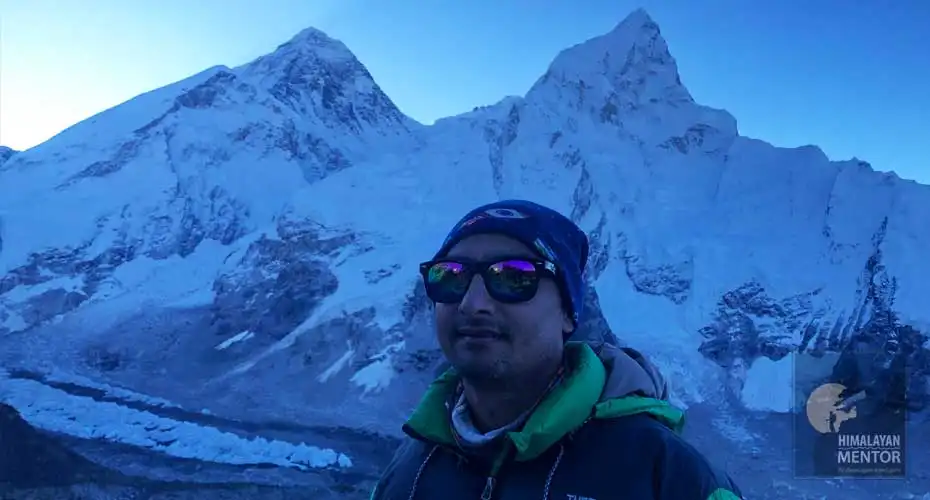
The trek also offers a chance to explore the serene Buddhist monasteries scattered along the trail, providing insight into a culture steeped in history and tradition, intricately linked to the very mountains that offer unforgettable vistas.
Overall, the Everest Base Camp hike is a truly special and transformative journey, combining natural beauty, cultural immersion, and a sense of historical significance that leaves trekkers with cherished memories and a profound connection to the Himalayas.
Where is Everest Base Camp (EBC)?
Nestled amidst the breathtaking Himalayan peaks, Everest Base Camp (EBC) stands as a sanctuary for climbers, offering a place of respite and readiness before embarking on the grand ascent of the world's tallest mountain. A realm of adventure and determination awaits those who venture to this iconic location.
Interestingly, there are two distinct base camps designated for climbers aiming to conquer Mount Everest. The North Base Camp resides in the captivating terrain of Tibet, while the South Base Camp is situated within the borders of Nepal. However, it is the Nepalese camp that has captured the hearts and imaginations of most, fondly referred to as Everest Base Camp. Over the years, it has become synonymous with the ultimate mountaineering dream.
Amidst this awe-inspiring backdrop, Everest Base Camp finds its sanctuary within the revered grounds of Sagarmatha National Park. A UNESCO World Heritage Site, this protected area serves as a haven for preserving the enchanting flora and fauna that flourish in the Himalayan ecosystem, ensuring the conservation of this natural wonder.
The journey to Everest Base Camp commences approximately 150 kilometers (90 miles) northeast of Kathmandu, Nepal's vibrant capital city. Nestled in the captivating Khumbu region, EBC sits gracefully at an altitude of 5,364 meters (around 17,598 feet) above sea level. Here, trekkers are welcomed by the splendor of nature and the warmth of the Sherpa culture, creating an unforgettable expedition of a lifetime.
As you tread the path leading to Everest Base Camp, be prepared to witness breathtaking vistas, experience the camaraderie of fellow adventurers, and immerse yourself in the magnificence of the Himalayas. It is a journey that weaves together the indomitable human spirit and the sheer grandeur of Mother Nature—a journey that will leave an indelible mark on your soul.
How to Trek to Mount Everest Base Camp?
For those seeking to conquer the legendary Mount Everest Base Camp, there are three primary options to undertake this exhilarating trek. Each route offers a distinct experience, catering to different preferences and levels of confidence. Let's explore these options to find the perfect fit for your epic journey.
- Organized Trekking Adventure through an Agency: If you prefer a well-structured and guided experience, opting for a package tour through a reputable agency is an excellent choice. This option proves particularly beneficial if you're traveling alone or lack the confidence to trek unassisted. While it may be a tad more expensive, the convenience and guidance provided by the agency make it worth the investment. It offers a supportive environment as you embark on this challenging adventure.
- Independent Trek with a Guide or Porter: For those craving more flexibility in their trekking journey, embarking on an independent hike while hiring a guide or porter is an ideal option. This allows you to navigate the trails at your own pace while benefitting from the expertise and insights of knowledgeable guides. In Kathmandu, finding capable porters and guides is a breeze—simply approach Himalayan Mentor, and they'll readily assist you in organizing the perfect team to cater to your needs. Sherpa guides, in particular, possess an intimate knowledge of the trail, ensuring a memorable and enriching experience.
Whether you choose the guided approach, opt for support from guides or porters, or venture forth on your own, the path to Mount Everest Base Camp awaits your footprints. An unforgettable adventure awaits as you immerse yourself in the majesty of the Himalayas and the vibrant culture of the Sherpa people. Embrace the challenge, cherish the camaraderie, and relish the beauty of this awe-inspiring journey—one that will undoubtedly leave you with cherished memories for a lifetime.
How difficult is the Everest Base Camp Trek?
For individuals with a medium to good level of fitness, the Everest Base Camp trek poses a moderate to strenuous challenge. Over the course of 12 days, you'll be trekking for approximately 4 to 6 hours daily, with occasional resting days for acclimatization. If you possess reasonable fitness, carrying your own backpack should be manageable, but having porters can certainly ease the load. Notably, no technical climbing skills are required for this trek.
Regardless of your fitness level, ascending too rapidly can lead to altitude sickness, so a gradual approach is essential. Some sections of the Everest Base Camp route involve steep climbs to higher elevations.
During our EBC trek covering a distance of 120 km (approximately 75 miles), you'll be averaging about 15 km per day for two weeks. The terrain is far from flat, as it is typical of Nepali treks, featuring numerous ascents and descents. While the distance covered may not demand super fitness, the high altitude makes it undeniably challenging. Starting at 2800m and ascending 2400m more to reach the base camp at 5365m requires acclimatization and endurance.
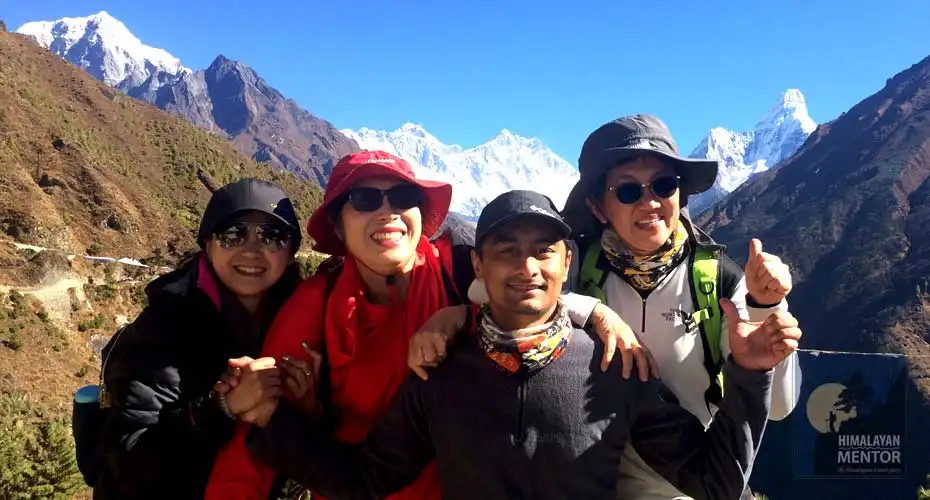
The difficulty of the Everest Base Camp Trek can be influenced by factors such as the weight of your backpack, where having a porter can significantly alleviate the strain. Additionally, the season plays a role; adverse weather conditions and feeling cold and uncomfortable can intensify the challenge.
Embracing the difficulties of the Everest Base Camp trek is part of the adventure. With determination, proper preparation, and a mindful pace, you can conquer the majestic heights of the Himalayas and create memories that will stay with you forever.
Best Time for the Everest Base Camp Trek
The Everest Base Camp trek offers two prime seasons for an unforgettable journey. The first opportune period is during the pre-monsoon season, encompassing March, April, and May. The second ideal time is in the post-monsoon season, spanning from late September to November. These months provide the best conditions for a safe and enjoyable trek to Everest Base Camp.
It is crucial to avoid hiking in unfavorable weather, as it can be unpleasant and hazardous. The Winter months, from December to February, are possible for trekking, but they come with extreme cold, with nighttime temperatures plummeting to as low as -30°C. Additionally, heavy snowfall on the trail and the potential closure of passes can make winter trekking more challenging.
In contrast, the pre-monsoon and post-monsoon seasons offer relatively stable weather, providing an excellent opportunity to explore the awe-inspiring Himalayas in comfort. During these periods, you can bask in the breathtaking beauty of the region while enjoying safer and more manageable trekking conditions.
By choosing the best time to trek Everest Base Camp, you can optimize your experience, ensuring a remarkable adventure that will leave you with cherished memories for a lifetime.
Estimating Your Expenses (Cost) for the Everest Base Camp Trek
For those planning to embark on the iconic Everest Base Camp trek, knowing the potential costs can help in budgeting and making informed decisions. Here is a breakdown of the various options and their corresponding expenses for the trek:
For budget-conscious trekkers planning an independent 12-day EBC trek, allocating around $1350 should suffice to cover essential expenses such as flights, food, water, tea, snacks, and accommodation. An excellent money-saving opportunity lies in choosing an overland route to Lukla instead of flying, which will take more days and advnetures.
It's worth noting that ATMs are only available in two locations along the Everest Base Camp hike: Lukla and Namche Bazaar. Therefore, it's essential to plan your cash withdrawals accordingly, ensuring you have access to funds during your trekking journey.
With these cost estimates in mind, you can now plan your Everest Base Camp trek with confidence, knowing the financial aspects are well within your grasp. Embrace the adventure, immerse yourself in the awe-inspiring beauty of the Himalayas, and create memories that will last a lifetime.
Accommodation during the Everest Base Camp Trek
When embarking on the adventurous journey to Everest Base Camp, trekkers can find comfort and respite in Teahouses, the quintessential accommodation along the trail. Teahouses are charming bed and breakfast lodges thoughtfully designed to cater to the needs of trekkers, offering a cozy and welcoming atmosphere.
Nestled in the mesmerizing landscapes of Nepal, EBC teahouse accommodations exude simplicity, cleanliness, and comfort. Their allure lies in the convenience they provide—checking in and having an early start the following day with a hearty breakfast is a hassle-free affair, ensuring trekkers are well-prepared for the day's challenges.
As for the cost of tea house accommodation, it is remarkably budget-friendly, with prices varying from US $5 and around $10 as long as you place an order for food at the teahouse.
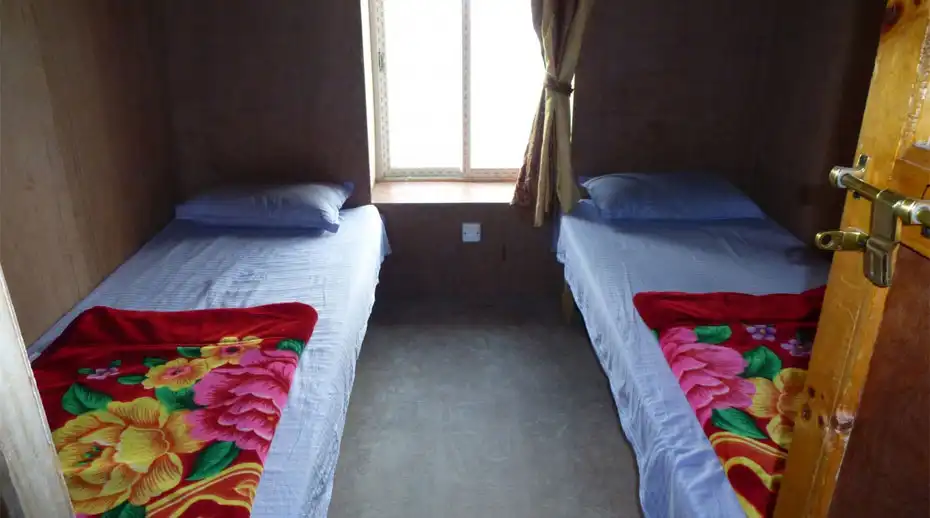
Teahouses' walls are known to be thin, and the temperatures inside and outside tend to be quite similar. However, to combat the chilly nights at higher altitudes, the teahouses provide warm blankets. Trekkers usually find that sleeping in a thin sleeping bag, bundled up in their clothes under the provided blankets, is sufficient to stay comfortably warm during the cold mountain nights.
So, as you venture along the path to Everest Base Camp, take solace in the inviting embrace of Teahouses, where you can rest, rejuvenate, and prepare yourself for the wondrous experiences that lie ahead.
The Shower Experience on the Everest Base Camp Trek
As you ascend on the Everest Base Camp trek, you'll notice that amenities become pricier, and this includes the luxury of a hot shower. Once you reach Namche Bazaar, you might have to pay around NPR 500 for a refreshing hot shower. After a long day of trekking, this indulgence is undoubtedly worth it, providing much-needed relaxation and comfort.
However, if you choose to trek early in the season, you might encounter frozen water in the pipes, making hot showers unavailable. In such instances, trekkers have the option of a bucket shower, where hot water is poured into a bucket for a makeshift cleansing experience. While this method suffices, the bitter cold of February at Gorkshep can make it less enjoyable.
To adapt to the circumstances, some trekkers pack Wet Wipes, using them for a 'dry shower' to freshen up when traditional showers are not feasible. Additionally, it's essential to carry hand sanitizer for washing hands when water or soap is unavailable, ensuring personal hygiene throughout the journey.
Embrace the challenges and adaptability on the Everest Base Camp trek, where even simple tasks like showering take on a different dimension amidst the rugged beauty of the Himalayas.
Power (Electricity) and Amenities at Tea Houses on the EBC Trek
During the Everest Base Camp trek, it's essential to be mindful of power availability and amenities at the tea houses. While there are lights in the rooms, most tea houses do not have electrical plugs in the bedrooms. As a result, if you need to charge your devices, you can do so in the communal area, usually at an additional cost of around 200 to 500 NPR per item or per hour.
To access electricity for charging, you'll typically find sockets available in the dining room. However, please note that this convenience comes with an extra charge.
The tea houses boast large dining halls, providing a cozy space to dine and relax alongside fellow guests. In the heart of the dining room, a fireplace fueled by wood and yak dung emanates warmth, making it a popular gathering spot during chilly mountain evenings.
As for the restroom facilities, you'll find that most tea houses now offer Western toilets for added comfort. However, it's important to bring your own supply of toilet paper, as it may not be provided.
Additionally, there are some more luxurious lodges available in certain villages along the trek, offering upgraded amenities for a price range of $30 to $180 per night. These lodges provide a touch of comfort amidst the rugged mountain terrain, allowing trekkers to relax and rejuvenate before continuing their journey.
As you embark on this incredible adventure to Everest Base Camp, understanding the available amenities will help you prepare accordingly, ensuring a rewarding and unforgettable experience amidst the majestic Himalayas.
Food on the Everest Base Camp Trek
Throughout the Everest Base Camp trek, the tea houses offer a delightful array of meals that cater to trekkers' appetites. Most people opt to enjoy 2 or 3 meals per day at the tea houses where they lodge. It's customary to have dinner and breakfast at the tea house of your overnight stay, as veering from this practice may result in higher accommodation charges (around $20 instead of the usual $8).
With a budget of approximately $35 per day (equating to around $12 per meal), you can savor delicious and satisfying dishes throughout your journey.
Among the staple foods relished by many on this trek is Dhal Bhat—a nourishing dish favored by porters and trekkers alike. At most places, Dhal Bhat is served "bottomless"—as your plate empties, they gladly refill it with more dahl, rice, and potatoes. If you find yourself in need of a refill, simply ask, and they will be more than happy to oblige! Besides Dal Bhat, Thukpa (noodle soup), Momos (dumpling), Sherpa stew, a variety of Soups, Macaroni, Spaghetti, Potato, Pizza, Sandwiches, Yak steak, Burger with chips, Spring Rolls are popular foods at most of the tea houses.

Typically, trekkers opt for a late lunch upon arrival at their destination (around 15:00) and a fairly early dinner (around 19:00) to prepare for the day ahead. Staying hydrated is vital on the EBC trek, but it's important to note that water from taps is not suitable for drinking. To quench your thirst, you can purchase water bottles at each teahouse. Some trekkers, however, prefer using a Lifestraw Bottle to make tap water potable, providing a more sustainable and eco-friendly option.
As you venture through the breathtaking landscapes of the Himalayas, let your taste buds revel in the delightful offerings of the tea houses, savoring the nourishing meals that fuel your unforgettable journey to Everest Base Camp.
The Flights to Lukla, the Gateway to Everest Base Camp Trek
The most convenient way to kickstart your epic Everest Base Camp trek is by catching a flight from Kathmandu to the Tenzing-Hillary Airport in Lukla.
The flights directly from Kathmandu to Lukla were temporarily suspended due to heavy air traffic during high season (Mid March to May and Mid September to November), prompting travelers to opt for flights departing from Ramechap Airport instead. During low season (winter and summer) you can fly from Kathmandu to Lukla and back.
The flexibility of adjusting flight dates during your trek is a boon, allowing you to make necessary changes without any additional charges (for the return flight, also need to check the availability). Himalayan Mentor helps your to modified your return date while trekking by making a simple phone call or message.
For a smoother journey, we strongly recommend reserving the earliest flight in the morning. Lukla's weather conditions can change rapidly, and flights are susceptible to cancellations due to high winds.
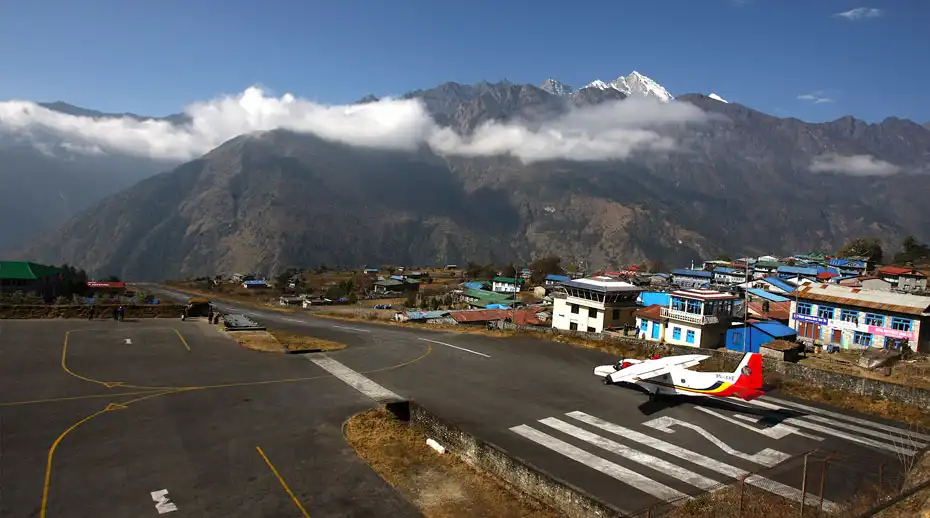
Be mindful of luggage restrictions; you are permitted only 10kg of luggage. So, ensure your packing is within the allowable limit. If you happen to carry more baggage, consider staying at a Kathmandu accommodation that offers safe storage without any additional fees.
Landing at the sloping Tenzing-Hillary Airport in Lukla can be quite an exhilarating experience, as it is often regarded as one of the most challenging runways globally. But fear not, for the breathtaking views and the adventures that lie ahead make it all worthwhile.
With your wings set for Lukla, you're on the cusp of an extraordinary journey—a trek that will test your spirit, unveil the wonders of the Himalayas, and leave you with cherished memories to last a lifetime. Let the grand adventure begin!
Guides and Porters for Everest Base Camp Trek
When it comes to hiring guides and porters for the Everest Base Camp trek, it is more common to arrange this in Kathmandu rather than in Lukla. While you may encounter touters or guides approaching you in Kathmandu, the safest approach is to go through a reputable local agency like Himalayan Mentor. This ensures that you have a reliable point of contact in case of any issues, and your guide won't unexpectedly disappear during the trek.
At times, we organize for you to meet your guide at Lukla airport. Typically, Himalayan Mentor provides a guide to accompany you from Kathmandu, and the guide's flight fare is included in the trek cost. For Nepalese citizens, there is a reduced price of $140 for the return flight. While you don't have to cover your guide's food and accommodation expenses, it's important to ensure that your guide is registered and insured.
Sharing a porter between two people is a practical option, as long as you don't overload them. A maximum weight of 20kg for a porter is reasonable, although some companies allow porters to carry up to 25 kg.
For budgeting purposes, you can allocate around $35 per day for a guide, which can be shared among up to four people. Likewise, plan to tip the porter and guide generously, as it is customary and a significant part of their income. These individuals work tirelessly to make your trek enjoyable and memorable, and a show of appreciation through tipping goes a long way in acknowledging their hard work.
Bear in mind that the efforts of these remarkable guides and porters enhance your trekking experience, making it an extraordinary journey to Everest Base Camp. By ensuring their well-being and recognizing their dedication, you contribute to fostering a positive and mutually rewarding experience for all.
Is a Guide Mandatory to Trek to Everest Base Camp?
In March 2023, the Nepal Tourism Board made an announcement that initially raised questions among trekkers planning to visit Everest Base Camp. The announcement stated that all tourists visiting Nepal would be required to hire a licensed guide or porter before undertaking any trek. However, the municipality responsible for the Everest region took a different stance. They decided not to enforce this requirement, thereby allowing solo trekking to continue in the Everest area, making it an exception to the rule. Still better to have a guide with a registered trekking company.
Permits for the Everest Base Camp Trek
To embark on the captivating Everest Base Camp trek, two essential permits are required: a national park permit and a trekker’s card. The good news is that both permits can be conveniently obtained while trekking on the trail.
For foreign nationals, the Khumbu Rural Municipality Permit(Trekker’s Card) is a mandatory requirement. It costs NPR 2,000 (approximately $20) per person for the initial four weeks of the trek. After completing four weeks, the permit cost increases to NPR 2,500 per person. You can easily acquire this permit at the permit office located on the trail in Lukla.
Another vital permit is the Sagarmatha National Park Entry Permit, which costs NPR 3,000 (around $25) plus a 13% government tax. This permit can be obtained either at the entrance gate in Monjo or at the Department of National Park and Wildlife Conservation (DNPWC) counter at Bhrikuti Mandap in Kathmandu.
Throughout your journey to Everest Base Camp, ensuring that you have these permits is crucial, as they not only grant you access to the captivating landscapes but also contribute to the conservation efforts in this remarkable region. With permits in hand, you are all set to immerse yourself in the majestic beauty of the Himalayas and embrace the adventure that awaits you. Himalayan Mentor help you to obtain all permits once you book the EBC Trek.
What to Pack for the Everest Base Camp Trek?
Trekking to Everest Base Camp is a challenging and adventurous journey that takes you through varying terrains and altitudes. Having the right personal equipment is crucial for your comfort, safety, and overall experience during the trek. Here are some essential personal items you'll need for the EBC trek:
Clothing: Proper clothing is essential to protect you from the cold weather and harsh conditions. Some of the key clothing items you'll need include waterproof jackets and trousers, down jackets, trekking trousers, thermal layers, hiking socks, gloves, and hats. The type of clothing required may vary depending on the season of your trek.
Footwear: Sturdy and comfortable footwear is essential. A good pair of worn-in, waterproof hiking boots is necessary to tackle the rugged trails. Additionally, having a pair of lightweight trainers or camp shoes is useful for relaxing at the teahouses or campsites in the evenings.
Sleeping Gear: A four-season sleeping bag, a sleeping bag liner, and optionally, a pillowcase are recommended for a comfortable night's rest.
Trekking Poles: These can be helpful to provide stability and reduce the strain on your knees during the trek.
Head Torch: A head torch is essential for navigating in the dark, especially during early morning starts or late-night activities.
Water Bottles and Purification: Carrying at least two water bottles (one liter each) and a water purification system (e.g., water purification tablets or a water filter like Lifestraw) is crucial to stay hydrated throughout the trek.
Toiletries: Bring essential toiletries such as biodegradable wet wipes, hand gel, sunscreen, lip balm, and any personal medication you may require.
First Aid Kit: A basic first aid kit with items like painkillers, band-aids, blister plasters, rehydration sachets, anti-diarrhea tablets, and any prescribed medications should be included.
Tech and Electronics: Depending on your preferences and needs, you may want to bring a power bank, charging cables, and electronic devices like your phone, iPod, or Kindle for entertainment or communication.
Personal Documents: Don't forget to carry important documents like your passport, trekking permits, and any necessary travel insurance information.
Remember, the EBC trek is physically demanding and takes you to high altitudes, so it's essential to be well-prepared with the right personal equipment. Packing wisely will ensure you have a safe and enjoyable journey to Everest Base Camp. Kindly visit our Nepal trekking equipment checklist page to explore a comprehensive list of options for each type of equipment.
Securing Insurance for the Everest Base Camp Trek
Given the high altitude nature of the Everest Base Camp trek and the possibility of altitude sickness, having appropriate insurance is of paramount importance. In case of emergencies, helicopter evacuation is the most common means to safely descend from the mountain.
For trekking to an altitude of 6000m, which includes the elevation of Everest Base Camp at 5364m, it is essential to obtain travel insurance that covers such high altitudes. It's a resounding 'yes' when it comes to ensuring your safety and well-being during this challenging journey.
You have the flexibility to purchase insurance for the entire duration of your trip or solely for the trekking period. To determine the most suitable insurance company for your Everest Base Camp trek, feel free to reach out to us at Himalayan Mentor.
By securing the right insurance coverage, you can embark on your Everest Base Camp adventure with confidence, knowing that you are well-protected and prepared for any unforeseen circumstances that may arise along the way. Your safety and peace of mind are our utmost priority as you explore the majestic Himalayas on this extraordinary trek.
Potential Risks and Preventive Measures on the Everest Base Camp Trek
Among the risks associated with the Everest Base Camp trek, altitude sickness (AMS) looms largest. Additionally, stomach issues, like diarrhea, and potential flight problems when landing at Lukla airport, known as one of the world's most dangerous airports, are also concerns.
To prevent altitude sickness, it's crucial to ascend gradually, allowing your body time to acclimatize. One effective approach is to undertake a training and acclimatization trek like the Langtang trek before embarking on the EBC trek. Spending time at higher elevations during the acclimatization process can help reduce the risk of AMS. While the highest point on the EBC trek is 5,364m (17,598ft) above sea level, most of the trek is at lower elevations.
Altitude sickness can affect anyone, regardless of age, fitness level, or trekking experience. It's essential to heed AMS symptoms, such as headaches, fatigue, dizziness, and difficulty sleeping. If mild symptoms occur, it's generally safe to proceed, but be cautious, as AMS can be dangerous if ignored.
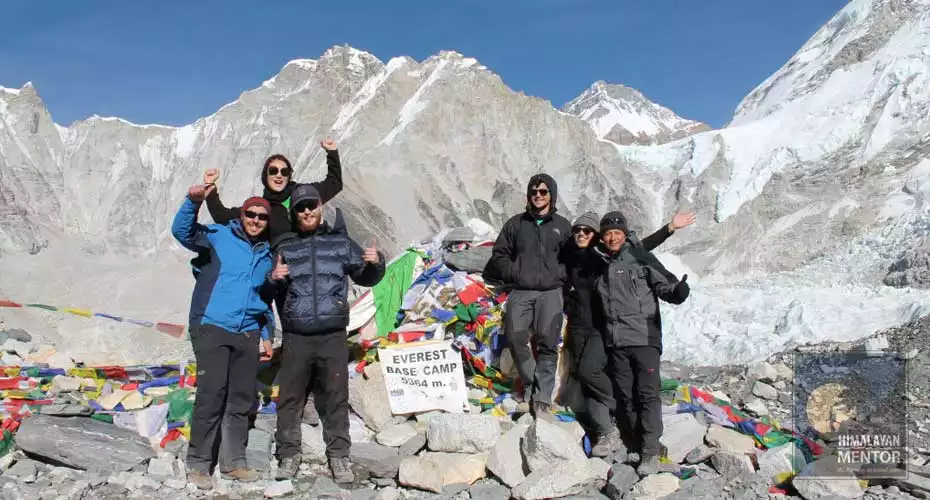
Taking Diamox is a common preventive measure against AMS, as it acts as a respiratory stimulant, helping combat the effects of low oxygen at high altitudes. While some trekkers experience minor side effects like tingling sensations in their fingertips, many find it helpful without any adverse effects.
Proper hydration is crucial during the trek, so remember to drink enough water. Maintaining a reasonable trekking pace is equally important, with a recommended increase in altitude not exceeding 600m per day.
If AMS symptoms become severe, it is essential to prioritize your health and not hesitate to rest or descend to lower altitudes. Experienced sherpas at tea houses along the route can offer valuable advice, and there is a clinic in Periche with international doctors providing guidance on AMS.
Flexibility in your itinerary is vital. Allow yourself to walk at a comfortable pace and listen to your body's signals. Ignoring severe symptoms can lead to dangerous situations and costly helicopter evacuations, so it's wise to have proper insurance coverage.
By being vigilant, taking necessary precautions, and respecting your body's needs, you can make your Everest Base Camp trek a safe and gratifying adventure, ensuring that you return with unforgettable memories of this majestic journey.
Alternative Routes to Explore around Everest Base Camp
Apart from the classic Everest Base Camp trek, there exist several thrilling alternatives that hikers and climbers can embark upon to witness the grandeur of this magnificent mountain. Here are some of the most popular treks and climbs near EBC:
Lukla to Salleri Route – For those seeking a unique adventure, consider taking a bus from Kathmandu to Salleri and trekking from there to Lukla. By choosing this route, you can bypass the need for flights to reach EBC. This hike not only allows for proper acclimatization but also saves you a substantial sum on flight expenses!
Journey to Everest Base Camp via Gokyo Lakes – For an extended and mesmerizing experience, add three or four days to your EBC trek by venturing towards Gokyo Lakes. Situated between 4,700m and 5,000m, these six spectacular glacial lakes offer breathtaking panoramic views of renowned mountains like K43, Taboche, Cholatse, Nuptse, and of course, Everest. This route involves crossing the challenging Cho La Pass, presenting both beauty and a sense of adventure.
Climb Island Peak (6,189m/20,305ft) or Lobuche East Peak (6,119m/20,075ft ) – If you seek serious mountaineering, Island Peak or Lobuche Peak is a compelling option. Unlike trekking, this is a true climb requiring specific mountaineering skills. Conquering a 6,000m peak is an extraordinary achievement. Many adventurers opt to combine Island Peak with their EBC trek, adding an extra three days to their journey. Consider combining your Everest Base Camp trek with the exhilarating Lobuche East Peak climbing experience for an unforgettable Himalayan adventure.
Everest 3 passes trek - If you want to enjoy your adventure climbing to Everest base camp, and challenge your body's stamina by crossing 3 high passes that are above 5000 meters during the trek, Everest base camp trek with 3 passes might be your choice of journey.

Each of these alternative routes offers its unique charm and challenges, catering to diverse preferences and aspirations of trekkers and climbers. Whether you choose to take the road less traveled or embark on classic routes, the beauty and allure of the Everest region will undoubtedly leave an indelible mark on your heart. Prepare for an adventure of a lifetime!
